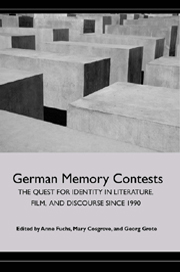Book contents
- Frontmatter
- Contents
- Acknowledgments
- Introduction: Germany's Memory Contests and the Management of the Past
- Positions
- Mediations
- 4 Being Translated: Exile, Childhood, and Multilingualism in G.-A. Goldschmidt and W. G. Sebald
- 5 “Ein Stück langweiliger als die Wehrmachtsausstellung, aber dafür reprüsentativer”: The Exhibition Fotofeldpost as Riposte to the “Wehrmacht Exhibition”
- 6 German Crossroads: Visions of the Past in German Cinema after Reunification
- 7 Monika Maron's Pawels Briefe: Photography, Narrative, and the Claims of Postmemory
- Ethnicity/Hybridity
- Memory Politics
- Works Cited
- Notes on the Editors and Contributors
- Index
5 - “Ein Stück langweiliger als die Wehrmachtsausstellung, aber dafür reprüsentativer”: The Exhibition Fotofeldpost as Riposte to the “Wehrmacht Exhibition”
from Mediations
Published online by Cambridge University Press: 05 February 2013
- Frontmatter
- Contents
- Acknowledgments
- Introduction: Germany's Memory Contests and the Management of the Past
- Positions
- Mediations
- 4 Being Translated: Exile, Childhood, and Multilingualism in G.-A. Goldschmidt and W. G. Sebald
- 5 “Ein Stück langweiliger als die Wehrmachtsausstellung, aber dafür reprüsentativer”: The Exhibition Fotofeldpost as Riposte to the “Wehrmacht Exhibition”
- 6 German Crossroads: Visions of the Past in German Cinema after Reunification
- 7 Monika Maron's Pawels Briefe: Photography, Narrative, and the Claims of Postmemory
- Ethnicity/Hybridity
- Memory Politics
- Works Cited
- Notes on the Editors and Contributors
- Index
Summary
This essay examines divergent approaches to the scholarly analysis and public exhibition of a particular corpus of photographic images: photographs taken by, or of, Wehrmacht soldiers during the Second World War. Though my title refers to the two exhibitions whose competing approaches are my central concern, properly speaking the exhibitions in question numbered three: two related but distinct exhibitions organized by the Hamburger Institut für Sozialforschung (hereafter HIS) on the subject of the crimes of the Wehrmacht, which ran from 1995–1999 and from 2001–2004 respectively; and, sandwiched between them in the year 2000, the exhibition Fotofeldpost: Geknipste Kriegserlebnisse 1939–1945, mounted by the Deutsch-Russisches Museum Berlin-Karlshorst (hereafter DRM) and concerned with the practice of amateur photography among soldiers on the Eastern Front. After some preliminary considerations, my essay addresses two interrelated issues: how Fotofeldpost diverged in its approaches from the first of the so-called Wehrmacht Exhibitions; and how the photo-historical scholarship that fed into, built on, or ran parallel to the exhibitions constructs the figure of the soldier-photographer.
There is a fine line between analyzing a memory contest that took place in reality and staging one in retrospect, in the process of writing cultural history. As evidence that this particular contest is not of my own imagining I could cite early reviewers of Fotofeldpost, who labeled the exhibition “eine Art Gegenausstellung” (a kind of counter-exhibition) and “die andere Wehrmachtsausstellung” (the other Wehrmacht exhibition).
- Type
- Chapter
- Information
- German Memory ContestsThe Quest for Identity in Literature, Film, and Discourse since 1990, pp. 107 - 126Publisher: Boydell & BrewerPrint publication year: 2006

